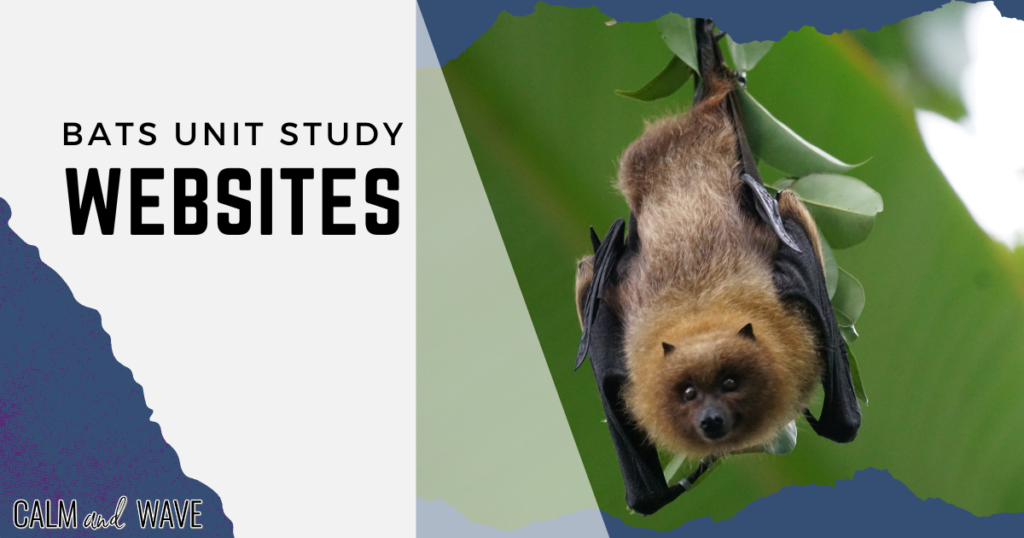This post may contain affiliate links. This means I may earn some money should you choose to sign up for a program or make a purchase using my link. I only recommend companies or items that I love and think you will too!

Homeschool Bats Unit Study
Before we fly into the bat homeschool unit study, let's talk about why we should learn about bats. Bats get a bad rap. They are depicted in so many movies as scary, bloodthirsty creatures who are coming to suck your blood. While yes, I must admit, seeing them fly around our house in the twilight may give me a fright. I am so thankful for the flying mammals. According to the USDA, bats are excellent at keeping insects such as mosquitos, beetles, and cricket populations in check. If you live in a place that has mosquitos you know how amazing that fact but that's not all! Bats also help to pollinate flowers and spread seeds for trees and plants. Now without further adieu let's get into some ways to learn more about these fascinating flying mammals with this bat homeschool unit study.

Looking for a digital resources to go along with your bat unit? Check out this bats digital interactive notebook.
Bat Unit Study Topics to Cover
Some topics to cover when learning about bats might be appearance, diet, predators, habitat, echolocation, adaptation, and classification. You can even add some other school subjects, besides science, into this bats homeschool unit study. Let's dive into each topic.
Bats Appearance
Most people know what bats look like; you've probably seen pictures of them silhouetted in the moon around Halloween. Their long wings, furry bodies, snouts, and ears are very recognizable. Did you know that bats are mammals? In fact, they are the only true flying mammals. Bats are generally divided into two groups: megabats and microbats. Megabats, sometimes fruit bats, can grow to have a wingspan of up to 5.5 feet. These bats eat mostly fruit and are nocturnal, meaning they are active at night and sleep during the day. Microbats are likely the bats you think of if you live in the United States. They can grow to have a wingspan of about 6 inches. These bats can use echolocation to find their food. The bats make a sound and then can interpret the wavelength as it returns to see if there is any prey.
Add math into your unit study by graphing the different wingspans of various bats.
Bats Habitat
Most bats live in colonies or large groups. They tend to spend their days in caves, trees, old buildings, or under bridges. At night you will find them where the insects are, around ponds, in the trees, or just about anywhere. Bats inhabit almost every continent, living in different habitats, including rainforests, woodlands, urban communities, deserts, etc. Some bats will migrate yearly to hibernate during the winter.
Add geography into your unit study by mapping the locations of bat habitats. Or find a specific bat and and trace their migration path. Add science/art to your unit study by making a diorama of a bat habitat.
Bats Diet
Bats' diet varies between the two groups. Megabats eat mostly fruit and are called frugivorous. In comparison, microbats primarily eat insects such as flies, mosquitos, moths, and more. These bats would be considered carnivores, or more specifically, insectivores. Some bats, the vampire bats, will feed on the blood of large mammals.
Add health to your unit and discuss a balanced diet for humans vs bats.
Bats Predators
The biggest threat to bats is not what you might think. A condition known as “white-nose syndrome,” caused by a fungus, grows on bats' muzzles, ears, and wings. The fungus has killed millions of bats in the Eastern U.S. and Canada. Animal predators of the bat would include owls, hawks, cats, and some snakes. To combat being eaten, bats hunt at night to avoid most predators.
Add science into your unit study and discuss food webs.
Bats Classification
Scientific classification is how scientist categorizes and therefore organize all of life. It helps scientists to identify the relationships between different species easily.
Here is an example of the scientific classification for the common vampire bat.
Kingdom: Animalia
Phylum: Chordata
Class: Mammalia
Order: Chiroptera
Family: Phyllostomidae
Genus: Desmodus
Species: Desmodus rotundus
Add in science/language by learning about how we get scientific names. (check out the guide to root words linked on this website)
Bats Vocabulary Words
- carnivore
- colony
- mammal
- migrate
- echolocation
- hibernation
- nocturnal
Read on to find videos, websites, book suggestions, crafts, field trip ideas, digital interactive notebook, and more to use in your homeschool bat unit study.

Video Links
If you purchased our digital interactive notebook for bats. These bat videos would be great to link to inside the digital notebook.
Cool Facts About Bats
All About Bats for Kids
3 Fun Facts About Bats
How Do Bats See with Sound?

Website Links
Here are some links to websites that have great information for kids about bats.
Smithsonian Bat Facts
San Diego Zoo Bat
US Dept of the Interior Bat Facts
National Geographic Bats Facts
NatGeo Kids Bat Facts

Book Suggestions for Homeschool Bats Unit Study
A homeschool bats unit study wouldn't be complete without some awesome books to read. These options are great to use as either read-along or for the student to read on their own. You can also find some great options on Thriftbooks, and if you use this link you can get a free book once you spend $30.







Craft Ideas
These bat crafts will appeal to both younger and older homeschoolers. Plus, if you choose to build a bat house, you will be helping out your local bat community.
Bat House
Origami Bat
Flapping Bat Craft
How to Draw a Cartoon Bat
How to Draw a Realistic Bat
Digital Interactive Notebook for Bats Homeschool Unit Study
Purchase Bats Digital Notebook HERE

Field Trip Ideas
New to Digital Homeschooling?












